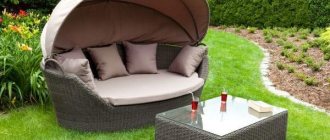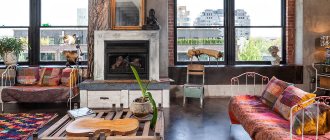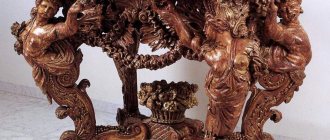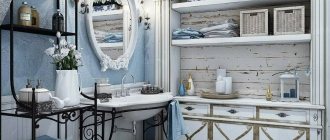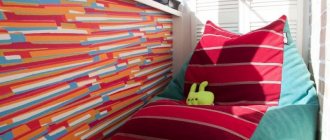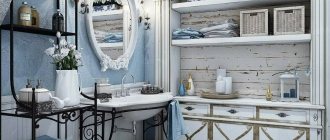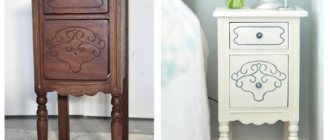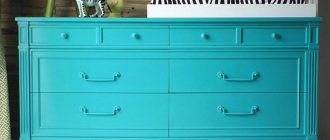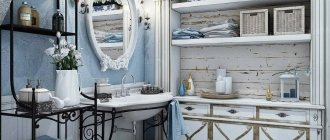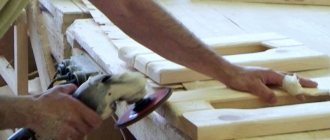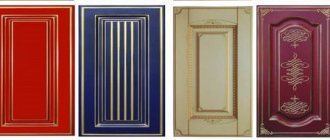Natural patina is a change in the color of a wooden surface as a result of a long period of time, oxidation and contact with hands.
Artificial patina on wood is a plaque on the coating of interior items that appears as a result of forced aging. This method of decoration gives newly made furniture an antique effect and protects it from wear, and prolongs the life of old furniture.
How to make a patina on furniture with your own hands
If the furniture is already boring, then you can give it an unusual appearance. To do this, they use a unique and interesting technology; it radically changes interior items and adds originality and novelty. One such method that helps turn furniture into a piece of art is the patina method. This is a process where a product is specially aged, giving it an antique and decorative appearance. When furniture is treated in this way, the naturalness of the fine lines and patterns of the natural wooden surface is emphasized, because the substances that make up the paint penetrate deeply into the wood. Patina makes it possible to imitate aged gilding or silver plating. This technology is accessible to novice decorators; even a beginner can master it. Today, all means for treating wooden surfaces are available on sale.
Originally, patina was the name given to a layer of copper that had oxidized. It was found on mirror frames, furniture, columns and other architectural objects located on the estates of wealthy people.
It was not possible to specifically achieve the effect of patinated furniture, so only many years later did interior items acquire this appearance. At this point, a bluish or greenish film appeared on these products.
Over time, patina was the name given to all the plaque that appeared on wood and metal surfaces.
What features does the patina effect have?
Since previously patina was a thin oxide film on copper, today a similar color can be achieved using improvised means.
The easiest way is to rub the wax mixture into the corners, edges and recesses of wooden objects. The result of the work is the effect as if the structure of the tree had become dirty over time.
At home, you can use paints that match the tone of the furniture, and add aluminum or bronze powder to them, it is commercially available. This is how you make patina with your own hands.
Please note that patination is the same as staining, but instead of regular paints, special coloring compounds are used that leave the internal tissues of the wood intact. Therefore, this coating can be easily removed if you do not like the result.
Main materials used for patination:
1. Paints containing small particles of precious metals - silver, gold or bronze. The coating that is obtained after using such paints remains more durable than real patina. The compositions are less porous, and their dense texture protects the wood from destruction. 2. Any paint on a familiar base that has an antique effect will do. Choose any shade, variety allows. Patina can be not only gold or silver, but also unexpected shades, for example, red.
The technology contains several stages. Upon closer examination of surfaces with a patina effect, you will notice that on the furniture there is a transition from darkening to a convex texture of the pattern, and in some places there is a clear indication of gold or silver. For example, you can really notice cracks on kitchen furniture - as if the paint or varnish has cracked over time.
How to make a patina on furniture with your own hands. There are several ways.
Methods used when applying patina:
1. Simple patination is the most acceptable option for covering furniture with your own hands. To do this, apply the main composition to the surface, which will serve as a base. Use a primer to level the area, which will also improve the adhesion of the coating composition. After this, sand the layer using a metal sponge or sandpaper. With strong movements, a greater effect of antiquity will appear. 2. Patination with bronze, silver or gold. The process is complex and requires the application of several layers. Shades of gold and silver are used when covering protruding patterns in order to give them a more beautiful appearance. It is better to use this method for furniture with a matte finish, since glossy furniture will only distort the patina effect. 3. Craquelure and patination are one of the most expensive pleasures, because the technology is complex, and two effects are achieved here. It is necessary to achieve not only cracks, but also the appearance of a patina of old age. First, apply the base so that cracks appear: make several layers without waiting for the previous one to dry. Use beveled varnish. If there are a lot of layers, they will crack. Then the desired shade is applied and sanded until the desired effect appears.
Patinating furniture in 7 steps
How to patina MDF facades with your own hands? Let's look at step-by-step instructions for achieving the desired look of antique furniture.
- We sand the facade using a sanding machine or manually with fine sandpaper. Remove the varnish layer, if any. Thoroughly clean the surface of any dust generated during the sanding process.
- Apply wood stain to the entire surface in an even layer. To do this, use a spray bottle, roller or brush. Remember that the stain layer should dry for at least 8-10 hours, ideally more. Take your time to achieve the best result.
- We varnish the product with self-priming varnish . Self-priming varnish is a product that combines the properties of varnish and primer. Wait for it to dry completely.
- We sand the façade again after the applied layers of stain and varnish have dried. Manual sanding is sufficient.
- We apply the patination composition to the façade using a spray bottle or a professional sprayer. When painting, pay special attention to recesses, patterns, and even areas. You should not patina the handles of cabinet doors; the decor in such a place will not last long.
- We create abrasions by carefully sanding with sandpaper or rags. Be patient, this is the longest stage of work.
- We cover the created abrasions with a final layer of varnish .
You can work in a similar way with solid wood, and with MDF, and with veneered facades, and with furniture covered with PVC film. Furniture covered with PVC film with patina is affordable, durable, functional and aesthetically pleasing.
This process is undoubtedly painstaking and requires skill, patience and skill, but with a strong desire it can be mastered. To begin with, we would like to recommend that beginners try their hand not on an expensive cabinet, but on unnecessary material. This way you will master the technique and avoid mistakes in the future.
For work, choose the safest materials, if possible, those that do not have a toxic odor, take care of your health and the well-being of your household and pets.
As can be seen from our article, the process of painting and patination of MDF facades of kitchen sets is undoubtedly interesting. Show your imagination and diligence, and your home will be filled with a truly unique and charming atmosphere of antiquity!
Did you like the article? Tell your friends about it:
- 8
- 3
- 2
How to prepare a work surface: tips
First, pay attention to the condition of the surface.
If the furniture is made of solid wood that has not been processed, then the work is simplified. Difficulties will arise when working with varnished and smooth surfaces. To make our task easier, we will carry out the following measures: 1. Rub the surface with a metal sponge or sandpaper. This will make the soft fibers of the wood coarse. Now it will be easier to apply the coloring composition on the created surface. 2. Using a soft brush, remove dust and degrease the surface.
Then take brushes and brushes special for such purposes, and use them to apply paint to the surface, allowing the layers to dry. Then wax and sand the wood. However, each method has its own set of coloring agents and processing tools.
Well, it’s not difficult to make a patina yourself, so anyone, after reading the instructions for work, can independently give a second life to boring furniture.
DIY wood patina
Natural patina is a change in the color of a wooden surface as a result of a long period of time, oxidation and contact with hands.
Artificial patina on wood is a plaque on the coating of interior items that appears as a result of forced aging. This method of decoration gives newly made furniture an antique effect and protects it from wear, and prolongs the life of old furniture.
What is patination
Patination of furniture is used to give it a fashionable decorative effect of antiquity. Wooden doors and floors, windows, and picture frames are also patinated. Artificial patina comes in dark, colored, metallic and white. This method can be used to restore kitchen furniture, bedroom sets, and dining sets.
The most popular option is aged white, patinated furniture for interiors in country, Provence and Mediterranean styles. Patination with milk paint and gilding is widely used. This decor looks especially impressive on furniture sets in a classic style.
The process of patination of furniture made of natural wood involves applying special compounds to its surface. They are applied to corners, edges, and in relief recesses. This is how hardwood is processed: oak, beech, ash, birch, etc.
And if under natural conditions the aging of furniture facades, the nobility of paint darkened and peeling off over time is only possible if we are talking about natural wood, then innovative techniques make it possible to achieve similar effects on MDF or chipboard.
Types and methods of applying patina
There are several DIY patination technologies. We will look at the three most common methods:
- By using the intensive grinding method, the result is a uniformly aged surface. To do this, after applying the patina, apply even movements using a metal mesh for washing dishes. It is its cellular structure that will create a unique, uniform aging effect. Some people use sandpaper of different grits. Experienced craftsmen can choose this grinding method, taking into account the difficulties of sanding. When choosing a patina color, you should choose it to be as contrasting as possible. The resulting effect will then be very noticeable;
- the method of highlighting certain segments of the facade is also very popular. It will be very relevant for framed facades or surfaces that have been milled. The essence of the method is very simple: select the desired color of the patina (very often gilding or silvering is chosen) and apply it with a brush to the required area. Gently wipe off the excess with a sponge. Afterwards we sand it lightly. Experts advise using matte varnish, which is ideal for gold or silver. If we apply gloss, then instead of “noble antiquity” we risk getting a “circus poster” with bright effects that are inappropriate in this case;
- The third method is called the “crackle effect”. It is not inferior in popularity to the first two options. When patination of a surface in this way, the result is the effect of cracks and peeling of the coating. This method can be combined with any of the previously described. The secret lies in applying special varnishes to the base before patination. To begin with, apply the first layer of varnish, and when it dries, apply the second. Both components begin to interact and create micropores and microcracks inside the varnish. A better effect will be obtained if you speed up the drying of the varnish layers using a hair dryer. A patination composition is applied into the cracks formed using a roller to obtain individual patterns or with a spray gun for a homogeneous, uniform pattern. It is worth remembering that after patination, to consolidate the crackle effect, you should immediately apply a protective layer of varnish.
Tools and materials
You can artificially age furniture at home. This will require some tools and materials.
To apply paint you will need several brushes - for each composition. For preliminary sanding, use sandpaper. When it comes to restoring wooden facades or countertops, a grinding machine is used to prepare the slabs. To wipe down the decorative layer, you will need a dry rag.
To increase the adhesive properties of the surface, surface priming is needed. The basic decorative material, onto which a patina is subsequently applied, is acrylic paint or stain.
The next layer of paint is patina, of which little will remain as a result. In order to further protect the furniture, the patina is coated with varnish. For an antique effect, choose a matte varnish.
For work at home, it is better to use safe water-based acrylic compounds. They are quite durable and easy to work with.
Possibility of using technology at home
Previously, only natural wood and metal products could be artificially aged using patination. Today, such an opportunity has arisen for MDF, which has significantly expanded the spread of technology in kitchen interiors. Many manufacturers sell MDF kitchen facades with a silver, gold or black patina, which look very extravagant and impressive.
Is it possible to apply the technology at home yourself, since at first glance it is quite complicated? It's definitely possible! In this case, the first impression is deceptive and the complexity of the technology is greatly exaggerated. Probably because of the amazing end result. There are a huge number of master classes in the currently fashionable hand made direction, where all stages of the process are described in detail. There are entire groups and forums where users share tips and tricks, helping each other and teaching beginners the art of patination.
To begin with, you should choose an object for experimentation. It will be the MDF facade from the kitchen cabinet.
Varieties of compositions and consistency
Previously, mechanical action was used to artificially age furniture, giving furniture a noble antique look. Interior items were kept in rooms with high humidity, rubbed and scratched. Innovative methods allow you to achieve the desired effect in the shortest possible time and in various ways.
Patina for wood, depending on consistency, can be of the following types:
| Thick. | Paste-like compositions, base and finishing, oxidizing the surface being treated with the effect of gilding or rust. |
| Liquid. | Varnishes that are often used as a topcoat to achieve a yellow tint. |
| Dyes. | Patination with acrylic paints is used for relief and carved furniture made of natural wood, MDF and chipboard. The stain is only suitable for natural wood. |
stain
The easiest and most affordable way to make a patina on wood is to treat it with stain. It penetrates deeply into the wood and protects it from moisture, UV rays, mold, and pests. Varieties:
- Water stain does not require a solvent. This coating has an additional effect, because the wood fibers rise after processing, and the structure of the material becomes more visible. The composition allows you to give the product a shade of valuable wood.
- Alcohol stain is a solution of aniline dye in ethanol. In addition to being decorative, the coating has an antiseptic function. The composition dries too quickly, so it is used for small surfaces or applied with a spray bottle.
- Oil stain is coloring pigments dissolved in linseed oil. The substance evenly covers the wood, does not lift the fibers, but emphasizes the pattern of natural wood. Diluted with white spirit.
Stains can have different colors. With their help, it will be possible to imitate the gray or greenish coating that appears on the surface of an old tree. They are not used for processing MDF and chipboard, and are not combined with silver and gold plating or craquelure.
Water-based wax patina in the form of a paste and finishing vintage wax are popular as finishing coatings. Wax-based paints dry slowly and are easy to rub. They are used for processing relief and textured slabs, cracks to obtain the effect of gilding, silvering, and bronze coating.
Wax pastes are made by mixing natural wax with a metallic pigment. They have good adhesion to wood and plastic, which is used to laminate MDF.
The colorless wax composition leaves a pearlescent sheen on the surface. Wax is used to retouch, restore and decorate old furniture. The composition is applied with a cotton rag or brush, rubbed in, and then polished with a rag, removing excess. The wax coating dries within 24 hours.
Wax paint can be used to tint unpainted and unprimed wood, emphasizing its structure and protecting the surface from moisture.
Acrylic
Acrylic paints for patination are suitable for processing natural wood, laminated MDF or chipboard sheets. They come in a variety of shades with individual effects. Acrylic paints imitate gray, beige, green and blue patina, rust, darkening, and fading. You can patina with acrylic the entire slab or only the relief decorative elements, monograms, and frames. For this purpose, paint with a gilded or blackened effect is used.
Variability
Products with film will delight you with a huge variety of colors, shades and textures. It is possible to order a product with a film that imitates expensive materials: valuable wood, leather, precious metals. It is possible to apply images and emboss.
Patination of the facade is aimed at creating the effect of antique furniture. There are two options for this design - wood effect and metal effect, but the shades, texture, and “natural” pattern are individual and very diverse. At the same time, using processing, you can make the color of the film brighter or, on the contrary, more muted.
Veneered facades look as if they are made of solid wood - solid, solid. They harmonize perfectly with wood products: MDF panels, tables, cabinets and others. For greater savings, you can not cover the entire surface with veneer, but use it as an accent on certain elements. The combination of veneer and enamel deserves special mention: this combination creates a luxurious image of furniture, emphasizing the sophistication and value of the product.
It is also possible to perform milling in each of the proposed options.
The most inexpensive are film facades. In second place are patinated ones. And the most expensive of those considered are veneered ones.
In all of the above there was not a word about safety. We considered it unnecessary to include this in a separate discussion, since the basis for the facades is tiles of compressed wood chips - one of the most environmentally friendly materials. Additional materials have similar characteristics - the film and varnish used in patination are non-toxic and do not emit harmful compounds. And veneer surpasses them in these properties.
Each material has both advantages and disadvantages. The choice in favor of any depends on the aesthetic preferences and financial capabilities of the customer. The main thing to remember is one thing - don’t skimp, then the facades will fit perfectly into the image of the furniture and will last a very long time.
What is patina?
Patina is an oxide film that appears on metal objects , primarily copper and bronze, under the influence of oxygen and moisture. This film has a special color and also creates an antique effect on the object where it appears. This is the original definition of the word.
Essentially, natural patina is a process of oxidation . But there is also an artificial type of this process .
Today, if someone says the word “patina” in relation to furniture, then he means a coating imitating antiquity that is applied to the furniture, or rather the effect of artificially aging furniture. This process is called "patination" of furniture.
Patination in furniture production
The furniture market offers various style and decorative trends. Aged furniture is reaching a new level, attracting people's attention at exhibitions.
Inexpensive furniture, having patinated facades, can mislead almost any person. At first glance, it will seem that in front of you is a kitchen or bedroom set made of expensive solid wood. But when you open the door, you will understand that the manufacturer used facades with patina. Technologies make it possible to apply the effect of antiquity on any surface - be it solid wood or MDF. Moreover, the use of MDF will only be visible on the inside, the finishing of which is impractical due to the high price.
A person who wants to buy a kitchen in a retro style will choose furniture with patina or a set with an antique effect, often used in the Provence style. A pleasant moment is not only the appearance of aged furniture, but also its price, which compares favorably with antiques.
Some people, having seen patina-applied facades on furniture, wonder whether it is possible to create such an effect with their own hands in order to update the appearance of boring furniture. Of course available. This will require knowledge, the skills of an artist, or the involvement of a person with creative abilities who, with his own hands, will be able to give the kitchen set or other furniture the desired effect.
Now let's take a closer look at this technology and study in detail the methods of creating facades with patina with your own hands.
What types of patina are there?
A natural patina that appears on metal objects as a result of the oxidation process.
There are two main types of patina on wooden furniture:
- Natural. It can also be called natural; it appears on its own from time to time, but not everywhere in those places where there are metal parts on the furniture.
- Artificial. As we have already mentioned, this is a whole process that allows you to artificially, thanks to the impact of special methods and compositions on wood, create the effect of aging furniture.
It is important to note that in the past the process of creating a patina was very difficult and took quite a long time. It took a lot of effort and a lot of time.
Now, thanks to modern furniture technologies, the patination process is much easier.
Benefits of patina. Why is it needed?
Now let's talk about why or what patina is needed. Why is it in widespread demand, especially recently?
What are the benefits of patina? What does it give?
There are several advantages, namely:
- Noble appearance . Applying a patina to furniture and the effect it creates can make the furniture stand out. Patina helps to age the wood and make its appearance more noble.
- The furniture looks more expensive than it costs. Furniture with patina looks rich and luxurious, but is not expensive. Looking at such a cabinet or bedside table, you might think that this is some kind of antique set, several dozen linen old, although in fact it was made only a few days ago.
But there are also advantages to applying patina to furniture, especially kitchen furniture. Let's look at them.
Three “yes” for applying patina:
- Additional protection. Kitchen facades that have a patina applied become stronger and last longer, because thanks to this additional layer they are less susceptible to damage.
- Practicality. An additional layer on the fronts of kitchen cabinets in de-patina also makes it easier to maintain the kitchen. This makes it easier to wash. Also, stains on patinated surfaces are not as noticeable as on regular ones.
- Aesthetics. Patination creates the effect of more expensive and antique furniture. Of course, patina is not suitable for every style, but for classics it is simply irreplaceable. Even a simple kitchen set made from cheap MDF will look more stylish thanks to patination.
Classic is always in fashion, and patina perfectly complements interior furniture in this style. Therefore, patina will always be popular too!
Patination is perfect for styles such as classic, country, Provence and chalet!
Furniture factory Mikavol uses the patination process to create kitchens and other cabinet furniture. We will help you bring the interior of your dreams to life, for little money!
Kitchen facades with patina: 3 types and do-it-yourself “aging” technologies
Fashion trends for antique furniture have also affected manufacturers of modern kitchen sets. Designers have developed and implemented a technology that produces kitchen facades with a patina that imitates antique furniture. Moreover, this process is not so complicated, and professionals who know how to handle tools and paints can create such a masterpiece with their own hands.
Facades with patina look chic and create a classic style
Request an offer
Old, slightly boring furniture can be given a second life by using a rather interesting and unique technology that will not only change its appearance, but also give it newness and originality. So, how to decorate your furniture yourself?
One of the ways that can turn your interior items into works of art is called patination. This is a process by which a product is aged and has a decorative, antique appearance. As a result of processing furniture in this way, it is possible to emphasize the naturalness of the lines and patterns of natural wooden surfaces, since the dyes penetrate deeply into the wood tissue. In this case, it is possible to imitate the effect of aged or worn-out gilding or silver plating. This technology is not difficult to master on your own and do the patination yourself. Today you can buy any means for treating wooden surfaces
The patina of wood, metals such as bronze, brass, copper, iron, as well as on stone, plaster or polyurethane foam looks chic and stylish. But this process must be carried out without haste and in compliance with all technology requirements.
Applying patina to wood
This process is simple and can be done at home. However, there is a difference in the processing and preparation of wood, metal and MDF and chipboard. The latter have a uniform structure, unlike wood, and therefore their painting, aging, decoupage and all other techniques have their own characteristics.
Preparatory stage
Wood and wood-fiber materials in kitchen furniture are not used in their original form. The furniture surface is protected by varnish, acrylic or PVC film, lamination, etc. Depending on the nature of this coating, you have to choose a paint with a patina and a method.
The patination master class takes into account all the features of materials.
- Wood for patina, tinting and varnishing is treated with a wire brush or coarse sandpaper. This method is called brushing. Its essence comes down to removing soft fibers and exposing the structure from harder ones. Brushing reproduces the natural aging process, but in an accelerated form. After removing the fibers, the surface is cleaned and treated with a degreasing compound.
The wood is not brushed before staining and painting, but only cleaned. Sanding is only needed to remove the varnish, if any.
Veneered MDF board can, in principle, be processed with sandpaper to give a scuffed effect, especially using the decoupage technique. But in practice, another method is preferable.
- A layer of barrier primer is applied to the MDF or chipboard board - this composition ensures adhesion of the top layer of MDF and chipboard to the primer, patina - gold, dark, silver color or paint. After drying, apply a second layer - polyurethane primer. It forms a base that will imitate scuffs or cracks. This second layer on the MDF board is then sanded with sandpaper to replicate the natural grain of the old wood.
The paints and compositions for patina for wood and MDF are the same. As for metal, in a furniture set it is represented only by fittings. Some of the compositions can be used for painting metal.
Patination of furniture using stain
This is the most accessible way to do it yourself; the master class lessons will tell you how to do it correctly. The effect is as close as possible to natural, which is best suited for classic styles. The color of the kitchen furniture will be darker, which needs to be taken into account.
- A layer of water-based stain is applied to the entire surface of the façade. The color of metal - brass, silver, gold - cannot be obtained here, but you can give cheap wood the appearance of expensive wood - oak, beech, walnut.
- Using a soft sponge, part of the composition is erased so as to create the effect of antiquity - from the middle areas, while the border, milling elements, and cracks remain untouched. You can use a sponge or brush. After drying, apply a second layer of stain, but always on a different base - white alcohol, for example.
- After drying, the surface is covered with shellac varnish with your own hands. If you want to enhance the effect of antiquity, antique wax is also rubbed into the wood.
The stain cannot be combined with painting or decoupage.
The video shows all the stages of patination of oak furniture.
Classic way
Patination is based on the use of special compounds - wax, oil, bitumen patina or even acrylic paint. The method is not much more complicated, so anyone can do it with their own hands, and even with the help of a master class. However, it assumes a wider range of colors: not only natural shades of oak, birch and walnut are possible here, but also metal colors - silver, gold, bronze, and even completely exotic shades.
The technology itself - after preparing the wood or MDF boards - is not much different from painting. The same tools are used, but unlike paint, patina hardens more slowly, which allows it to be thoroughly shaded and excess removed. In this way, the paint is not uniform, but fragmented.
- A layer of patina - wax, bitumen, acrylic, is applied with your own hands to the furniture surface. Its color, as a rule, is close to the natural shade of wood - oak, walnut. You can immediately remove excess paint to only emphasize the wood texture and darken the pores. In this case, the second layer is not applied, but covered, for example, with shellac varnish.
- To make kitchen furniture more impressive, wood or MDF board is covered with a second layer of patina. It is usually lighter as its purpose is to highlight dark pores. It is important to choose the right paint: 2-3 shades lighter if it is a classic interior, cover the kitchen facade with a patina of silver or gold color if it is a palace style, or use even colored paint, as, for example, Provence allows.
- After the second layer has dried, the surface is sanded with fine sandpaper or metal mesh to create a worn effect.
- The obtained result is fixed with varnish - acrylic or shellac. If the paint used is not the color of silver or brass, you should choose a matte varnish: antique products do not shine.
Creating abrasion
This method is equally good when painting wood and MDF, and when tinting, and even when using the decoupage technique, where decor is often combined with aging. Sometimes such patination is also called decoupage, although it has only an indirect relation to it.
The sequence of actions in this case is somewhat different.
- Paint the surface with paint or patina a couple of shades darker with your own hands.
- After drying, part of the product - the edges, milling or carved elements - is covered with a layer of paraffin. It is important to note that wax patina does not give such a result; the problem here is precisely in the method of application.
- Then the product is covered with a second layer of patina, usually lighter. Available in metal colors - brass, silver, bronze.
- The paraffin layer is removed with a spatula. Wood or MDF board is carefully sanded.
- The façade can then be stained and waxed if a natural feel is desired. If a metal color composition - silver, brass - was used for the second layer, then the product is simply coated with matte varnish.
In this way, an extremely believable antiquity effect is obtained. In the video, how to properly make patinated furniture with and without decoupage is discussed in detail.
Patination is an excellent design technique. With its help, the kitchen interior is given true aristocracy and elegance. In addition, artificial patina protects the wood from moisture.
The most suitable areas of furniture for patination
Dacha avant-garde
Before you start applying patina to wood yourself, you need to practice on some unnecessary piece of wood and master the patina technology itself. The main requirement in this process is measure. It is advisable not to overdo it, since the wooden surface will look most attractive if the patina is applied to the wood without excess. If there is a lot of paint, the structure of the wood is excessively variegated and it seems as if it has been smeared. The patina of furniture wood usually ages corners, edges, and edges. Craftsmen advise that it is better not to paint cabinet fittings and handles; paint in these places of frequent mechanical impact will not last long.
Wood patina can be applied to furniture in a variety of shades. Classic style and Provence looks impressive in white. Bedroom, kitchen and living room furniture with a black facade look chic with a silver patina. The furniture is covered with a patina in a color as close as possible to the natural shade of wooden surfaces: brown, golden, silver or milky white. They create the feeling that the furniture has been exposed to sunlight for a long time and is therefore faded and a little frayed.
Selection of materials and type of decoration
minimalis/CONSOLE
Furniture can be artificially aged by simple patination. In this case, a base composition is applied to the surface of the wood, which prepares the basis for applying a patina to the wood. By applying a primer, the surface is leveled and the adhesion of the patina composition is improved.
Acrylic or emulsion paints of various shades are used to decorate furniture.
In addition, to apply a patina to wood you will need the following materials:
– brushes of different sizes;
– fine-grained sandpaper or Scotch-Brite;
– a rag made of coarse fabric;
– two types of paint (one is darker than the surface being treated, the second is to imitate metal: bronze color or antique gold).
Having prepared all the necessary materials, you can begin to independently apply a patina to the wood of furniture products in a few steps.

